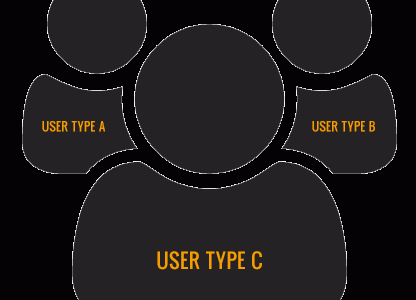User Scenarios in Web Design: The Nerdy Way
Posted on December 13, 2016 Mary Merritt
By now, you may or may not have noticed that NerdyMind is not your typical web design company. We don't (and won't) just jump into a design and fiddle with it until you are happy. Brace yourself for this statement: We're not interested in making YOU happy with our web designs. Nope. We're focused on making your USERS happy. When your users are happy, they will cruise through your funnel and right into your sales and operating process. Let's be real - your happiness is merely a by-product of their bliss. We love making you both happy, but we know that happy users means more conversions, more leads, more revenue and more growth for your business. If that doesn't make you smile, then we've got deeper issues!
So why don't we just get started on the web design already? Well, grasshoppers, before we start building the walls we must construct a strong foundation. That means understanding every different type of person who uses your website. This is where we start building out our "User Scenarios." Everything we do should be based on what your users want, what they need, and what their human characteristics are.
Step One: Building User Scenarios
Without going into too much detail, the first step in constructing your website to be an "ENGINE" for your business is building out some intelligent user scenarios. Before we create the actual scenarios, we brainstorm with our clients on the different user types. We use the term "users" instead of "customers" because sometimes people who use your website ARE NOT CUSTOMERS. Are we blowing your mind? A great example of this fact is your sales team. On many occasions we have seen that internal sales teams use the company website as a strong sales tool. The potential behind this fact would never be realized if we only considered paying customers as users.
Once we have a solid set of user types, we start mapping out what these people would be looking for. Usually, we start off with a sentence such as this:
"As a ___<USER ROLE>____, I need to ___<SOME GOAL>___ so that I can ___<SOME REASON>___."
A fully realized user scenario could be:
"As an influencer, I need to know everything there is to know about ACME Software's functional offering so that I can make an educated recommendation to my superiors."
Step Two: Wireframing and User Scenario Mapping
If we didn't engage in this part of the process, the first step is literally useless! This portion of the process exists to help create an amazingly focused design. Wireframes are great for web designers; they truly do allow the designer to focus on the look-and-feel of the site. They will not find themselves asking questions like: "What is supposed to go on this page and where?"
Once we have built the wireframes out, we make sure that each user type is engaged by creating a "User Scenario Map." This simply points out which content fulfills the needs of each user type. This exercise is extremely helpful in creating an overall content outline for the website as well.
Step Three: The Content Outline
Once we have completed wireframes and a fully-realized website navigation (which sometimes comes after a keyword research process as well), we can start developing a site content outline. This guides our customers to create content that is engaging, optimized, and user-focused. Sometimes we write the content, and sometimes our clients do. Either way, it ends up amazing because we all work together! By utilizing the user scenario map, the entire team knows exactly what each page should contain to properly engage potential customers.
Step Four: "Skinning" the Wireframes
The art of "skinning" a wireframe merely means to add a designer's touch. To achieve a solid wireframe, we must remove the idea of color theory, design and spatial relationships so that we can focus on what content goes in what "box." That's what a wireframe is: Boxes. The designer's job is to add images, color, typography and gorgeous spatial relationships to create a modern design. This is an iterative process that involves revisions, meetings, communication and teamwork.
Final Thoughts
As you can see, templates just won't cut the mustard. If you've taken the time to run through this type of web design process (with us or with someone else who believes in these vital steps), then you are the kind of person who believes in data-driven decisions, customer-focused activities and strategic thinking.
If you are a business owner and you are looking to run through a helpful, fun exercise, try building some user scenarios of your own! Think about who would be visiting your site and what they would be looking for. It's a really fun pursuit that will drive you to become even MORE customer-focused than you already are!

